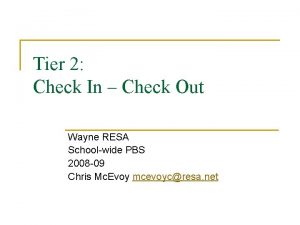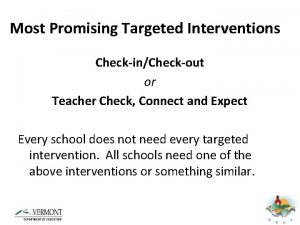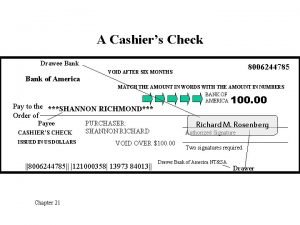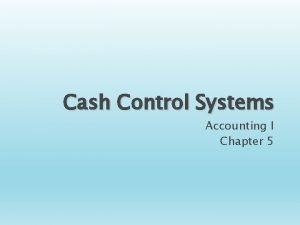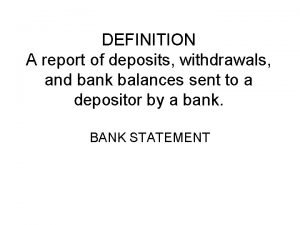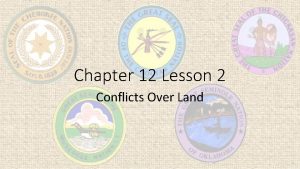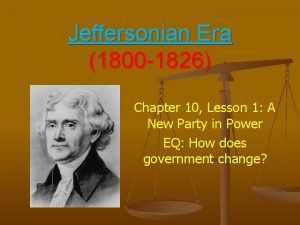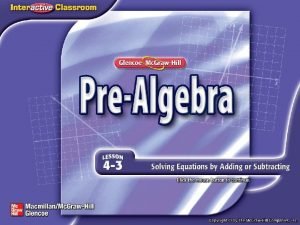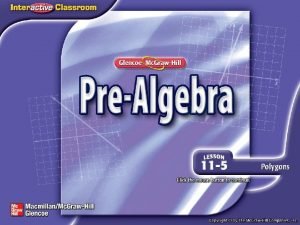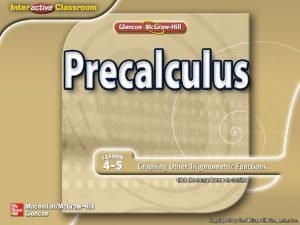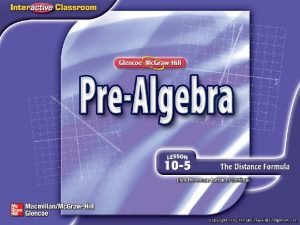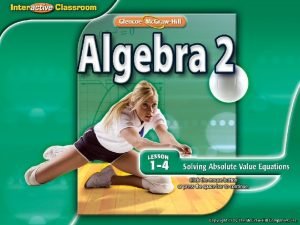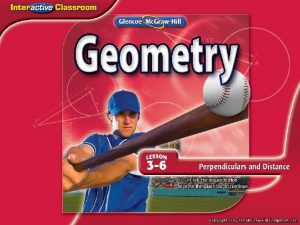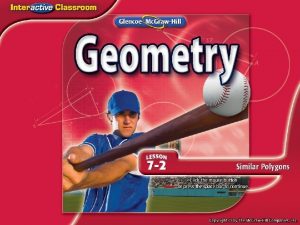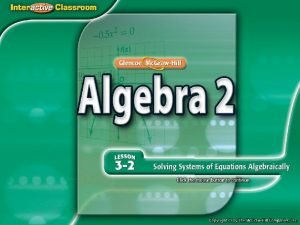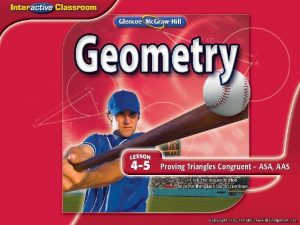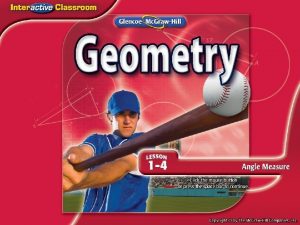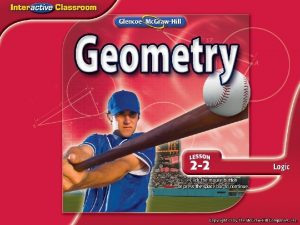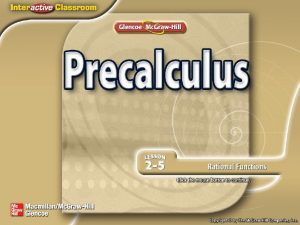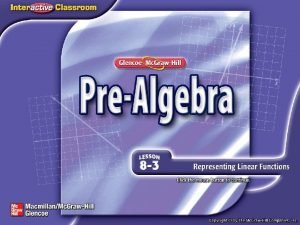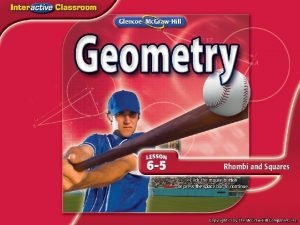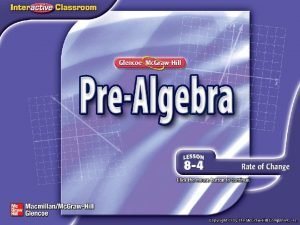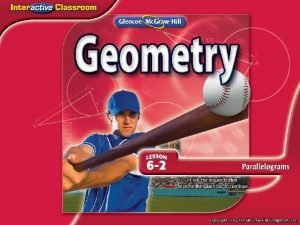FiveMinute Check over Lesson 7 2 ThenNow New











































- Slides: 43


Five-Minute Check (over Lesson 7 -2) Then/Now New Vocabulary Key Concept: Standard Forms of Equations for Hyperbolas Example 1: Graph Hyperbolas in Standard Form Example 2: Graph a Hyperbola Example 3: Write Equations Given Characteristics Example 4: Find the Eccentricity of a Hyperbola Key Concept: Classify Conics Using the Discriminant Example 5: Identify Conic Sections Example 6: Real-World Example: Apply Hyperbolas

Over Lesson 7 -2 Graph the ellipse given by 4 x 2 + y 2 + 16 x – 6 y – 39 = 0. A. B. C. D.

Over Lesson 7 -2 Write an equation in standard form for the ellipse with vertices (– 3, – 1) and (7, – 1) and foci (– 2, – 1) and (6, – 1). A. B. C. D.

Over Lesson 7 -2 Determine the eccentricity of the ellipse given by A. 0. 632 B. 0. 775 C. 0. 845 D. 1. 290

Over Lesson 7 -2 Write an equation in standard form for a circle with center at (– 2, 5) and radius 3. A. (x + 2)2 + (y – 5)2 = 3 B. (x + 2)2 + (y – 5)2 = 9 C. (x – 2)2 + (y + 5)2 = 9 D. (x – 2)2 + (y + 5)2 = 3

Over Lesson 7 -2 Identify the conic section represented by 8 x 2 + 5 y 2 – x + 6 y = 0. A. circle B. ellipse C. parabola D. none of the above

You analyzed and graphed ellipses and circles. (Lesson 7 -2) • Analyze and graph equations of hyperbolas. • Use equations to identify types of conic sections.

• hyperbola • transverse axis • conjugate axis


Graph Hyperbolas in Standard Form A. Graph the hyperbola given by The equation is in standard form with h = 0, k = 0,

Graph Hyperbolas in Standard Form Graph the center, vertices, foci, and asymptotes. Then make a table of values to sketch the hyperbola. Answer:

Graph Hyperbolas in Standard Form B. Graph the hyperbola given by The equation is in standard form with h = 2 and k = – 4. Because a 2 = 4 and b 2 = 9, a = 2 and b = 3. Use the values of a and b to find c. c 2 = a 2 + b 2 Equation relating a, b, and c for a hyperbola c 2 = 4 + 9 a 2 = 4 and b 2 = 9 Solve for c.

Graph Hyperbolas in Standard Form Use h, k, a, b, and c to determine the characteristics of the hyperbola.

Graph Hyperbolas in Standard Form Graph the center, vertices, foci, and asymptotes. Then make a table of values to sketch the hyperbola. Answer:

Graph the hyperbola given by A. B. C. D.

Graph a Hyperbola Graph the hyperbola given by 4 x 2 – y 2 + 24 x + 4 y = 28. First, write the equation in standard form. 4 x 2 – y 2 + 24 x + 4 y = 28 Original equation 4 x 2 + 24 x – y 2 + 4 y = 28 Isolate and group like terms. 4(x 2 + 6 x) – (y 2 – 4 y) = 28 Factor. 4(x 2 + 6 x + 9) – (y 2 – 4 y + 4)= 28 + 4(9) – 4 Complete the squares. 4(x + 3)2 – (y – 2)2 = 60 Factor and simplify.

Graph a Hyperbola Divide each side by 60. The equation is now in standard form with h = – 3,

Graph a Hyperbola Graph the center, vertices, foci, and asymptotes. Then make a table of values to sketch the hyperbola. Answer:

Graph the hyperbola given by 3 x 2 – y 2 – 30 x – 4 y = – 119. A. B. C. D.

Write Equations Given Characteristics A. Write an equation for the hyperbola with foci (1, – 5) and (1, 1) and transverse axis length of 4 units. Because the x-coordinates of the foci are the same, the transverse axis is vertical. Find the center and the values of a, b, and c. center: (1, – 2) Midpoint of segment between foci a =2 Transverse axis = 2 a c =3 Distance from each focus to center c 2 = a 2 + b 2

Write Equations Given Characteristics Answer:

Write Equations Given Characteristics B. Write an equation for the hyperbola with vertices (– 3, 10) and (– 3, – 2) and conjugate axis length of 6 units. Because the x-coordinates of the foci are the same, the transverse axis is vertical. Find the center and the values of a, b, and c. center: (– 3, 4) Midpoint of segment between vertices b =3 Conjugate axis = 2 b a =6 Distance from each vertex to center

Write Equations Given Characteristics Answer:

Write an equation for the hyperbola with foci at (13, – 3) and (– 5, – 3) and conjugate axis length of 12 units. A. B. C. D.

Find the Eccentricity of a Hyperbola Find c and then determine the eccentricity. c 2 = a 2 + b 2 Equation relating a, b, and c c 2 = 32 + 25 a 2 = 32 and b 2 = 25 Simplify.

Find the Eccentricity of a Hyperbola Eccentricity equation Simplify. The eccentricity of the hyperbola is about 1. 33. Answer: 1. 33

A. 0. 59 B. 0. 93 C. 1. 24 D. 1. 69


Identify Conic Sections A. Use the discriminant to identify the conic section in the equation 2 x 2 + y 2 – 2 x + 5 xy + 12 = 0. A is 2, B is 5, and C is 1. Find the discriminant. B 2 – 4 AC = 52 – 4(2)(1) or 17 The discriminant is greater than 0, so the conic is a hyperbola. Answer: hyperbola

Identify Conic Sections B. Use the discriminant to identify the conic section in the equation 4 x 2 + 4 y 2 – 4 x + 8 = 0. A is 4, B is 0, and C is 4. Find the discriminant. B 2 – 4 AC = 02 – 4(4)(4) or – 64 The discriminant is less than 0, so the conic must be either a circle or an ellipse. Because A = C, the conic is a circle. Answer: circle

Identify Conic Sections C. Use the discriminant to identify the conic section in the equation 2 x 2 + 2 y 2 – 6 y + 4 xy – 10 = 0. A is 2, B is 4, and C is 2. Find the discriminant. B 2 – 4 AC = 42 – 4(2)(2) or 0 The discriminant is 0, so the conic is a parabola. Answer: parabola

Use the discriminant to identify the conic section given by 15 + 6 y + y 2 = – 14 x – 3 x 2. A. ellipse B. circle C. hyperbola D. parabola

Apply Hyperbolas A. NAVIGATION LORAN (LOng RAnge Navigation) is a navigation system for ships relying on radio pulses that is not dependent on visibility conditions. Suppose LORAN stations E and F are located 350 miles apart along a straight shore with E due west of F. When a ship approaches the shore, it receives radio pulses from the stations and is able to determine that it is 80 miles farther from station F than it is from station E. Find the equation for the hyperbola on which the ship is located.

Apply Hyperbolas First, place the two sensors on a coordinate grid so that the origin is the midpoint of the segment between station E and station F. The ship is closer to station E, so it should be in the 2 nd quadrant. The two stations are located at the foci of the hyperbola, so c is 175. The absolute value of the difference of the distances from any point on a hyperbola to the foci is 2 a. Because the ship is 80 miles farther from station F than station E, 2 a = 80 and a = 40.

Apply Hyperbolas Use the values of a and c to find b 2. c 2 = a 2 + b 2 1752 = 402 + b 2 29, 025 = b 2 Equation relating a, b, and c c = 175 and a = 40 Simplify.

Apply Hyperbolas

Apply Hyperbolas Answer:

Apply Hyperbolas B. NAVIGATION LORAN (LOng RAnge Navigation) is a navigation system for ships relying on radio pulses that is not dependent on visibility conditions. Suppose LORAN stations E and F are located 350 miles apart along a straight shore with E due west of F. When a ship approaches the shore, it receives radio pulses from the stations and is able to determine that it is 80 miles farther from station F than it is from station E. Find the exact coordinates of the ship if it is 125 miles from the shore.

Apply Hyperbolas Because the ship is 125 miles from the shore, y = 125. Substitute the value of y into the equation and solve for x. Original equation y = 125 Solve.

Apply Hyperbolas Since the ship is closer to station E, it is located on the left branch of the hyperbola, and the value of x is about – 49. 6. Therefore, the coordinates of the ship are (– 49. 6, 125). Answer: (– 49. 6, 125)

NAVIGATION Suppose LORAN stations S and T are located 240 miles apart along a straight shore with S due north of T. When a ship approaches the shore, it receives radio pulses from the stations and is able to determine that it is 60 miles farther from station T than it is from station S. Find the equation for the hyperbola on which the ship is located. A. B. C. D.

 Behavior check in check out sheet
Behavior check in check out sheet Check in check out forms
Check in check out forms Check in check out
Check in check out Check in check out system for students
Check in check out system for students Cashiers check bank of america
Cashiers check bank of america Character generation methods in computer graphics
Character generation methods in computer graphics Behavior check-in
Behavior check-in Check in check out intervention
Check in check out intervention The fan blade is speeding up. what are the signs of
The fan blade is speeding up. what are the signs of Cash control systems
Cash control systems Check my progress vocabulary check
Check my progress vocabulary check Non depository institutions
Non depository institutions Over the mountains over the plains
Over the mountains over the plains Siach reciting the word over and over
Siach reciting the word over and over Taking over navigational watch
Taking over navigational watch An endorsement indicating a new owner of a check.
An endorsement indicating a new owner of a check. Chapter 5 cash control systems
Chapter 5 cash control systems Yun.ir refah new check
Yun.ir refah new check Check the old lesson
Check the old lesson Check the old lesson
Check the old lesson Module eleven lesson one self check quiz
Module eleven lesson one self check quiz As new industrialism swept over the land
As new industrialism swept over the land Chapter 12 lesson 2 conflicts over land
Chapter 12 lesson 2 conflicts over land Lesson 1 trouble over taxes
Lesson 1 trouble over taxes Punctuating split speech
Punctuating split speech New york pennsylvania new jersey delaware
New york pennsylvania new jersey delaware Fresh oil, new wine scripture
Fresh oil, new wine scripture Marquee cinemas - orchard 14
Marquee cinemas - orchard 14 3 weaknesses of the articles of confederation
3 weaknesses of the articles of confederation New-old approach to creating new ventures
New-old approach to creating new ventures Negative demand
Negative demand Njbta
Njbta New classical macroeconomics
New classical macroeconomics Chapter 16 toward a new heaven and a new earth
Chapter 16 toward a new heaven and a new earth Neil thisse is a loyalist answers
Neil thisse is a loyalist answers New classical and new keynesian macroeconomics
New classical and new keynesian macroeconomics Roosevelt taft wilson comparison
Roosevelt taft wilson comparison Lesson 4 the new order and the holocaust
Lesson 4 the new order and the holocaust Chapter 10 lesson 2 the louisiana purchase
Chapter 10 lesson 2 the louisiana purchase Chapter 10 lesson 1 a new party in power
Chapter 10 lesson 1 a new party in power Lesson 1 an introduction to oceania
Lesson 1 an introduction to oceania Chapter 15 the new frontier and the great society
Chapter 15 the new frontier and the great society Becoming a world power lesson 3 new american diplomacy
Becoming a world power lesson 3 new american diplomacy The jefferson era lesson 1
The jefferson era lesson 1
